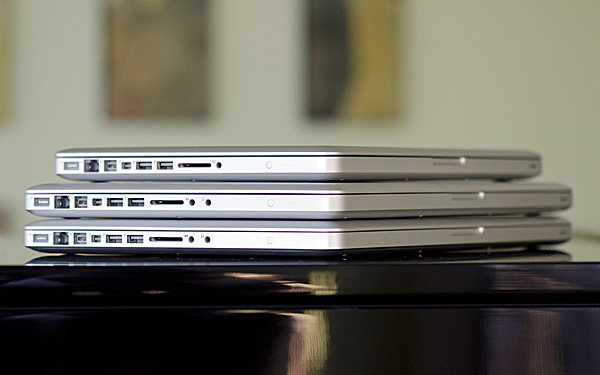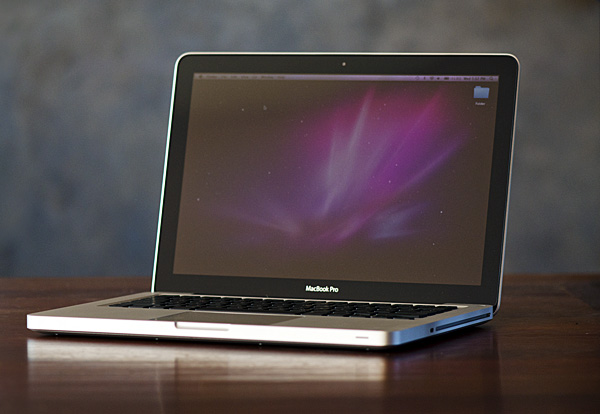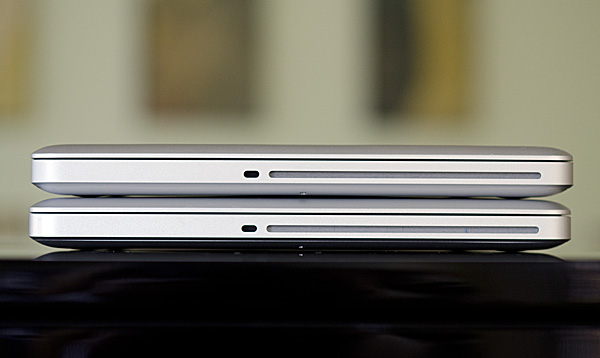The MacBook Pro Review (13 & 15-inch): 2011 Brings Sandy Bridge
by Anand Lal Shimpi, Brian Klug & Vivek Gowri on March 10, 2011 4:17 PM EST- Posted in
- Laptops
- Mac
- Apple
- Intel
- MacBook Pro
- Sandy Bridge
Last year at the iPad introduction Steve Jobs announced that Apple is a mobile device company. Just last week Steve returned to introduce the iPad 2 and point out that the majority of Apple's revenue now comes from products that run iOS. The breakdown is as follows:
| AAPL Revenue Sources—Q1 2011 | |||||||||
| iPad | iPhone | iPod | Mac | iTunes Store | Software/Services | Peripherals | |||
| Percentage | 17.2% | 39.1% | 12.8% | 20.3% | 5.4% | 2.9% | 2.2% | ||
Just looking at iPad and iPhone, that's 56% of Apple's sales. All Macs put together? Only 20%. Granted 20% of $26.7 billion in sales is still $5.3 billion, but the iOS crew gets most of the attention these days.
It shouldn't come as a surprise that when Apple launched its 2011 MacBook Pro lineup last week that it did so with little fanfare. There was no special press event and no video of an unusually charismatic man on a white background describing the latest features of the systems. All we got two weeks ago were a few pages describing the high level features of the lineup, a short outage on the Mac Store and five new configurations available for sale.

Apple tends to not mix architecture updates and chassis changes. The 2011 MacBook Pro lineup is no different. These models fundamentally implement the same updated unibody shell that was introduced in 2009. The term unibody comes from the fact that the base of the chassis is machined out of a single block of aluminum. There's no way to gain access to the MacBook Pro's internals from above, you have to go in from below. As a result there's absolutely no chassis flex or squeaking while you pound on the keyboard, use the trackpad or just interact with the part of the machine that you're most likely to be touching. Apple has been shipping unibody MacBook Pros since 2008 and from my experience the design has held up pretty well.

From top to bottom: 13-inch MBP (2011), 15-inch MBP (2011), 15-inch MBP (2010)
The biggest letdown in the design has been the hinge connecting the display to the rest of the chassis. I haven't had it fail completely but I've had it become frustratingly loose. Even brand new, out of the box, the 15-inch MacBook Pro will have its display move by a not insignificant amount if you tilt the machine 90 degrees so that the display is parallel to the ground. A number of readers have written me over the years asking if Apple has improved the locking ability of the hinge in each new version of the MacBook Pro. It doesn't seem to be any better with the 2011 model—sorry guys.
Other than screen size, ports and internals, there's nothing that separates the 13-, 15- and 17-inch MacBook Pros from one another. They all feature the same excellent backlit keyboard (keyboard size is constant across all models) and a variant of the same high quality display. All of them have the same front facing 720p camera and the same large glass-covered trackpad.
Battery capacity hasn't changed compared to last year, although power consumption on some models has gone up (more on this later).
| 2011 MacBook Pro Lineup | |||||||
| 13-inch (low end) | 13-inch (high end) | 15-inch (low end) | 15-inch (high end) | 17-inch | |||
| Dimensions |
0.95 H x 12.78 W x 8.94 D
|
0.95 H x 14.35 W x 9.82 D
|
0.98 H x 15.47 W x 10.51 D
|
||||
| Weight |
4.5 lbs (2.04 kg)
|
5.6 lbs (2.54 kg)
|
6.6 lbs (2.99 kg)
|
||||
| CPU |
2.3 GHz dual-core Core i5
|
2.7 GHz dual-core Core i7
|
2.0 GHz quad-core Core i7
|
2.2 GHz quad-core Core i7
|
2.2 GHz quad-core Core i7
|
||
| GPU |
Intel HD 3000 Graphics
|
Intel HD 3000 + AMD Radeon HD 6490M (256MB)
|
Intel HD 3000 + AMD Radeon HD 6750M (1GB)
|
Intel HD 3000 + AMD Radeon HD 6750M (1GB)
|
|||
| RAM |
4GB 1333MHz DDR3 (8GB max)
|
||||||
| HDD |
320GB 5400 RPM
|
500GB 5400 RPM
|
500GB 5400 RPM
|
750GB 5400 RPM
|
750GB 5400 RPM
|
||
| Display Resolution |
1280x800
|
1440x900 (1680x1050 optional)
|
1920x1200
|
||||
| Ports |
Gigabit LAN, Firewire 800, Thunderbolt, 2x USB 2.0, SDHC slot, combined audio in/out jack
|
Gigabit LAN, Firewire 800, Thunderbolt, 2x USB 2.0, SDHC slot, separate audio in/out jacks
|
Gigabit LAN, Firewire 800, Thunderbolt, 3x USB 2.0, separate audio in/out jacks, ExpressCard 34 slot
|
||||
| Battery Capacity |
63.5Wh
|
77.5Wh
|
95Wh
|
||||
| Price | $1,199 | $1,499 | $1,799 | $2,199 | $2,499 | ||
The new MacBook Pros are still equipped with DVD drives and thus Apple still distributes OS X and the application preload on a pair of DVDs. I was hoping Apple would go to an all-USB distribution starting with the MBA but it looks like we'll have to wait for another generation of Pro systems before we see that.












198 Comments
View All Comments
Anand Lal Shimpi - Friday, March 11, 2011 - link
Our top picks right now are either the Intel SSD 510 or something based on the SF-1200 controller (e.g. Corsair Force, OCZ Vertex 2). In the next month or so we should see the first wave of SF-2200 drives hit the market (e.g. OCZ Vertex 3). These things should scream. Keep an eye on our Storage section for new drives as we review them:http://www.anandtech.com/tag/storage
Take care,
Anand
phoible_123 - Thursday, March 10, 2011 - link
I purchased the low-end 13" the day it was released, and am super happy with it. I had been waiting for a while for a suitable upgrade to my 2007 White Macbook. I considered getting the last 15" (almost bought it), but I was worried about heat, size, and weight. Turns out that these concerns were justified, but the Sandy Bridge models seem to be much better.The performance of the new 13" is comparable to the old high-end 15". It is noticeably faster than the last-gen 13" (I have one of those at work). I don't really play games on my laptop, so I don't care about graphics (I have a desktop with a GTX460 at home hooked up to my HDTV).
I have played with all of the other laptops, and the build quality on the Macbook is just better than anything else I've seen. No question about it. Every time someone raves about some other laptop, I go to Best Buy and play with it, and I'm always disappointed (usually the keyboard and/or trackpad sucks, or the case is too flexy).
Sure, I could get a faster laptop for less money, but it wouldn't be as good at what i actually use it for (mostly software development). I got the low-end 13", and will use the money I saved to buy an Optibay and 128GB SSD (already upgraded the RAM to 8GB). The only laptop that could potentially beat it is the forthcoming MBA.
kigoi - Thursday, March 10, 2011 - link
ah except for when i bought it this is how it's gone for me too. and except for waiting to max memory if usage needs it. and maybe hoping for a slicker hybrid hard drive solution, something like the momentus xt but with more cache and a variable spindle.i wonder if the i5 model runs cooler than the i7. we stressed it with handbrake, experienced the fan, felt the underside. it didn't seem to get intolerably hot underneath unless there was zero airflow (like, on a bedcover).
oh btw here is a document of the hidden keyboard secrets of the fn key.
http://pludk.wordpress.com/2011/03/08/happy-accide...
kigoi - Friday, March 11, 2011 - link
oops error. the return of the hidden keypad was actually done by a software extension w/o my knowing. pretty thrilling to report that though, while it lasted.kanaka - Thursday, March 10, 2011 - link
I got my 15" AG yesterday and one of the first things i was impressed with was how sturdier the hing was compared to my existing Late 08 model.owbert - Thursday, March 10, 2011 - link
what is the trade offs between high res antiglare option and high (glossy) res display?kanaka - Thursday, March 10, 2011 - link
Glare vs no glare. Also colours are more saturated on the glossy screen. There's also a slight weight difference due to the glass vs no glass situation.mino - Thursday, March 10, 2011 - link
Simple: you trade "Bling!" for usability.gstrickler - Thursday, March 10, 2011 - link
More brightness and color saturation on the glossy screen, but more money better color accuracy, reduced glare, and slightly lower wright on the matte screen. The matte screen is also higher resolution than the standard screen, but you can get the hires screen in glossy or matte.One side benefit of the matte screen, in environments where glare may be a problem on the glossy screen (e.g. The Apple Store, many offices, etc), I find it's necessary to turn up the screen brightness on the glossy to overpower the glare. With the matte screen, I can use a lower screen brightness, which means less power, and better battery life. I'm not sure how much difference since I don't have a MBP with a glossy screen to perform a side by side test, but I estimate it at 15-30 mins.
dwade123 - Thursday, March 10, 2011 - link
The new Sony S is better.